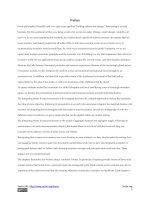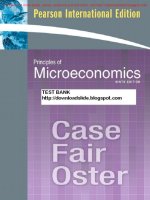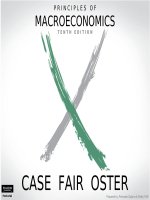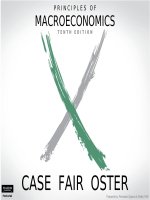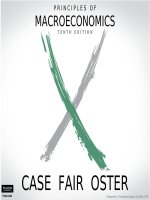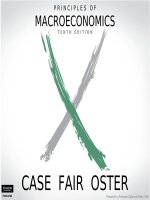Principles of macroeconomics 10e by case fair oster ch10
Bạn đang xem bản rút gọn của tài liệu. Xem và tải ngay bản đầy đủ của tài liệu tại đây (849.14 KB, 47 trang )
PRINCIPLES OF
MACROECONOMICS
PART III The Core of Macroeconomic Theory
TENTH
EDITION
CASE FAIR OSTER
© 2012 Pearson Education, Inc. Publishing as Prentice Hall
Prepared by: Fernando Quijano & Shelly
1 ofTefft
47
PART III The Core of Macroeconomic Theory
© 2012 Pearson Education, Inc. Publishing as Prentice Hall
2 of 47
The Money Supply
and the Federal
Reserve System
10
CHAPTER OUTLINE
An Overview of Money
What Is Money?
Commodity and Fiat Monies
Measuring the Supply of Money in the United States
The Private Banking System
PART III The Core of Macroeconomic Theory
How Banks Create Money
© 2012 Pearson Education, Inc. Publishing as Prentice Hall
A Historical Perspective: Goldsmiths
The Modern Banking System
The Creation of Money
The Money Multiplier
The Federal Reserve System
Functions of the Federal Reserve
Expanded Fed Activities Beginning in 2008
The Federal Reserve Balance Sheet
How the Federal Reserve Controls the Money Supply
The Required Reserve Ratio
The Discount Rate
Open Market Operations
Excess Reserves and the Supply Curve for Money
Looking Ahead
3 of 47
An Overview of Money
What Is Money?
Money is a means of payment, a store of value, and a unit of account.
A Means of Payment, or Medium of Exchange
PART III The Core of Macroeconomic Theory
barter The direct exchange of goods and services for other
goods and services.
medium of exchange, or means of payment What sellers
generally accept and buyers generally use to pay for goods
and services.
© 2012 Pearson Education, Inc. Publishing as Prentice Hall
4 of 47
PART III The Core of Macroeconomic Theory
Which field of economic theory does not require that we know
anything about money?
a.
Microeconomics.
b.
Macroeconomics.
c.
Neither microeconomic nor macroeconomic theory
requires that we know anything about money.
d.
None of the above. Both microeconomic and
macroeconomic theory require that we know quite a bit about
money.
© 2012 Pearson Education, Inc. Publishing as Prentice Hall
5 of 47
PART III The Core of Macroeconomic Theory
Which field of economic theory does not require that we know
anything about money?
a.
Microeconomics.
b.
Macroeconomics.
c.
Neither microeconomic nor macroeconomic theory
requires that we know anything about money.
d.
None of the above. Both microeconomic and
macroeconomic theory require that we know quite a bit about
money.
© 2012 Pearson Education, Inc. Publishing as Prentice Hall
6 of 47
An Overview of Money
What Is Money?
A Store of Value
PART III The Core of Macroeconomic Theory
store of value An asset that can be used to transport
purchasing power from one time period to another.
liquidity property of money The property of money that
makes it a good medium of exchange as well as a store of
value: It is portable and readily accepted and thus easily
exchanged for goods.
A Unit of Account
unit of account A standard unit that provides a consistent
way of quoting prices.
© 2012 Pearson Education, Inc. Publishing as Prentice Hall
7 of 47
PART III The Core of Macroeconomic Theory
Which of the following refers to the liquidity property of money?
a.
The fact that money makes a good medium of exchange.
b.
The fact that money is portable and comes in convenient
denominations.
c.
The fact that money is readily accepted and thus easily
exchanged for goods.
d.
All of the above.
© 2012 Pearson Education, Inc. Publishing as Prentice Hall
8 of 47
PART III The Core of Macroeconomic Theory
Which of the following refers to the liquidity property of money?
a.
The fact that money makes a good medium of exchange.
b.
The fact that money is portable and comes in convenient
denominations.
c.
The fact that money is readily accepted and thus easily
exchanged for goods.
d. All of the above.
© 2012 Pearson Education, Inc. Publishing as Prentice Hall
9 of 47
An Overview of Money
Commodity and Fiat Monies
commodity monies Items used as money that also have intrinsic
value in some other use.
PART III The Core of Macroeconomic Theory
fiat, or token, money Items designated as money that are
intrinsically worthless.
legal tender Money that a government has required to be accepted in
settlement of debts.
currency debasement The decrease in the value of money that
occurs when its supply is increased rapidly.
© 2012 Pearson Education, Inc. Publishing as Prentice Hall
10 of 47
E C O N O M I C S I N PRACTI C E
Dolphin Teeth as Currency
In most countries commodity monies are not
used anymore, but the world is a big place
and there are exceptions.
PART III The Core of Macroeconomic Theory
In the Solomon Islands, dolphin teeth are
being used as a means of payment and a
store of value.
Note that even with a currency like dolphin
teeth there is a concern about counterfeit
currency, namely fruit-bat teeth, but also
tooth decay.
Shrinking Dollar Meets Its Match in Dolphin Teeth
Wall Street Journal
© 2012 Pearson Education, Inc. Publishing as Prentice Hall
11 of 47
An Overview of Money
Measuring the Supply of Money in the United States
M1: Transactions Money
PART III The Core of Macroeconomic Theory
M1, or transactions money Money that can be directly
used for transactions.
M1 ≡ currency held outside banks + demand deposits +
traveler’s checks + other checkable deposits
© 2012 Pearson Education, Inc. Publishing as Prentice Hall
12 of 47
An Overview of Money
Measuring the Supply of Money in the United States
M2: Broad Money
PART III The Core of Macroeconomic Theory
near monies Close substitutes for transactions money, such
as savings accounts and money market accounts.
M2, or broad money M1 plus savings accounts, money
market accounts, and other near monies.
M2 ≡ M1 + savings accounts + money market accounts +
other near monies
© 2012 Pearson Education, Inc. Publishing as Prentice Hall
13 of 47
PART III The Core of Macroeconomic Theory
When you transfer $1,000 from your checking account to your
savings account, this transaction will:
a.
Decrease both M1 and M2.
b.
Decrease M1 and increase M2.
c.
M1 will remain the same and M2 will increase.
d.
M2 will remain the same and M1 will decrease.
© 2012 Pearson Education, Inc. Publishing as Prentice Hall
14 of 47
PART III The Core of Macroeconomic Theory
When you transfer $1,000 from your checking account to your
savings account, this transaction will:
a.
Decrease both M1 and M2.
b.
Decrease M1 and increase M2.
c.
M1 will remain the same and M2 will increase.
d.
M2 will remain the same and M1 will decrease.
© 2012 Pearson Education, Inc. Publishing as Prentice Hall
15 of 47
An Overview of Money
Measuring the Supply of Money in the United States
Beyond M2
There are no rules for deciding what is and is not money.
PART III The Core of Macroeconomic Theory
This poses problems for economists and those in charge of
economic policy.
© 2012 Pearson Education, Inc. Publishing as Prentice Hall
16 of 47
An Overview of Money
The Private Banking System
financial intermediaries Banks and other institutions that act as a
link between those who have money to lend and those who want to
borrow money.
PART III The Core of Macroeconomic Theory
The main types of financial intermediaries are commercial banks,
followed by savings and loan associations, life insurance companies,
and pension funds.
© 2012 Pearson Education, Inc. Publishing as Prentice Hall
17 of 47
How Banks Create Money
A Historical Perspective: Goldsmiths
run on a bank Occurs when many of those who have claims on a
bank (deposits) present them at the same time.
PART III The Core of Macroeconomic Theory
Today’s bankers differ from goldsmiths—today’s banks are subject to a
“required reserve ratio.”
Goldsmiths had no legal reserve requirements, although the amount
they loaned out was subject to the restriction imposed on them by their
fear of running out of gold.
© 2012 Pearson Education, Inc. Publishing as Prentice Hall
18 of 47
How Banks Create Money
The Modern Banking System
A Brief Review of Accounting
PART III The Core of Macroeconomic Theory
Assets − Liabilities ≡ Net Worth
or
Assets ≡ Liabilities + Net Worth
Federal Reserve Bank (the Fed) The central bank of the
United States.
reserves The deposits that a bank has at the Federal
Reserve bank plus its cash on hand.
required reserve ratio The percentage of its total deposits
that a bank must keep as reserves at the Federal Reserve.
© 2012 Pearson Education, Inc. Publishing as Prentice Hall
19 of 47
How Banks Create Money
The Modern Banking System
PART III The Core of Macroeconomic Theory
A Brief Review of Accounting
FIGURE 10.1 T-Account for a Typical Bank (millions of dollars)
The balance sheet of a bank must always balance, so that the sum of assets (reserves and
loans) equals the sum of liabilities (deposits and net worth).
© 2012 Pearson Education, Inc. Publishing as Prentice Hall
20 of 47
PART III The Core of Macroeconomic Theory
On the T-account of a bank:
a.
Reserves are on the liability side.
b.
Deposits are an important liability.
c.
Assets plus net worth equal liabilities.
d.
Assets are usually greater than liabilities plus net worth.
© 2012 Pearson Education, Inc. Publishing as Prentice Hall
21 of 47
PART III The Core of Macroeconomic Theory
On the T-account of a bank:
a.
Reserves are on the liability side.
b. Deposits are an important liability.
c.
Assets plus net worth equal liabilities.
d.
Assets are usually greater than liabilities plus net worth.
© 2012 Pearson Education, Inc. Publishing as Prentice Hall
22 of 47
How Banks Create Money
The Creation of Money
excess reserves The difference between a bank’s actual reserves
and its required reserves.
PART III The Core of Macroeconomic Theory
excess reserves ≡ actual reserves − required reserves
FIGURE 10.2 Balance Sheets of a Bank in a Single-Bank Economy
In panel 2, there is an initial deposit of $100.
In panel 3, the bank has made loans of $400.
© 2012 Pearson Education, Inc. Publishing as Prentice Hall
23 of 47
How Banks Create Money
PART III The Core of Macroeconomic Theory
The Creation of Money
FIGURE 10.3 The Creation of Money When There Are Many Banks
In panel 1, there is an initial deposit of $100 in bank 1. In panel 2, bank 1 makes a loan of $80
by creating a deposit of $80. A check for $80 by the borrower is then written on bank 1 (panel 3)
and deposited in bank 2 (panel 1). The process continues with bank 2 making loans and so on.
In the end, loans of $400 have been made and the total level of deposits is $500.
© 2012 Pearson Education, Inc. Publishing as Prentice Hall
24 of 47
How Banks Create Money
The Money Multiplier
An increase in bank reserves leads to a greater than one-for-one
increase in the money supply.
PART III The Core of Macroeconomic Theory
Economists call the relationship between the final change in deposits
and the change in reserves that caused this change the money
multiplier.
money multiplier The multiple by which deposits can increase for
every dollar increase in reserves; equal to 1 divided by the required
reserve ratio.
money multiplier ≡
© 2012 Pearson Education, Inc. Publishing as Prentice Hall
1
required reserve ratio
25 of 47

